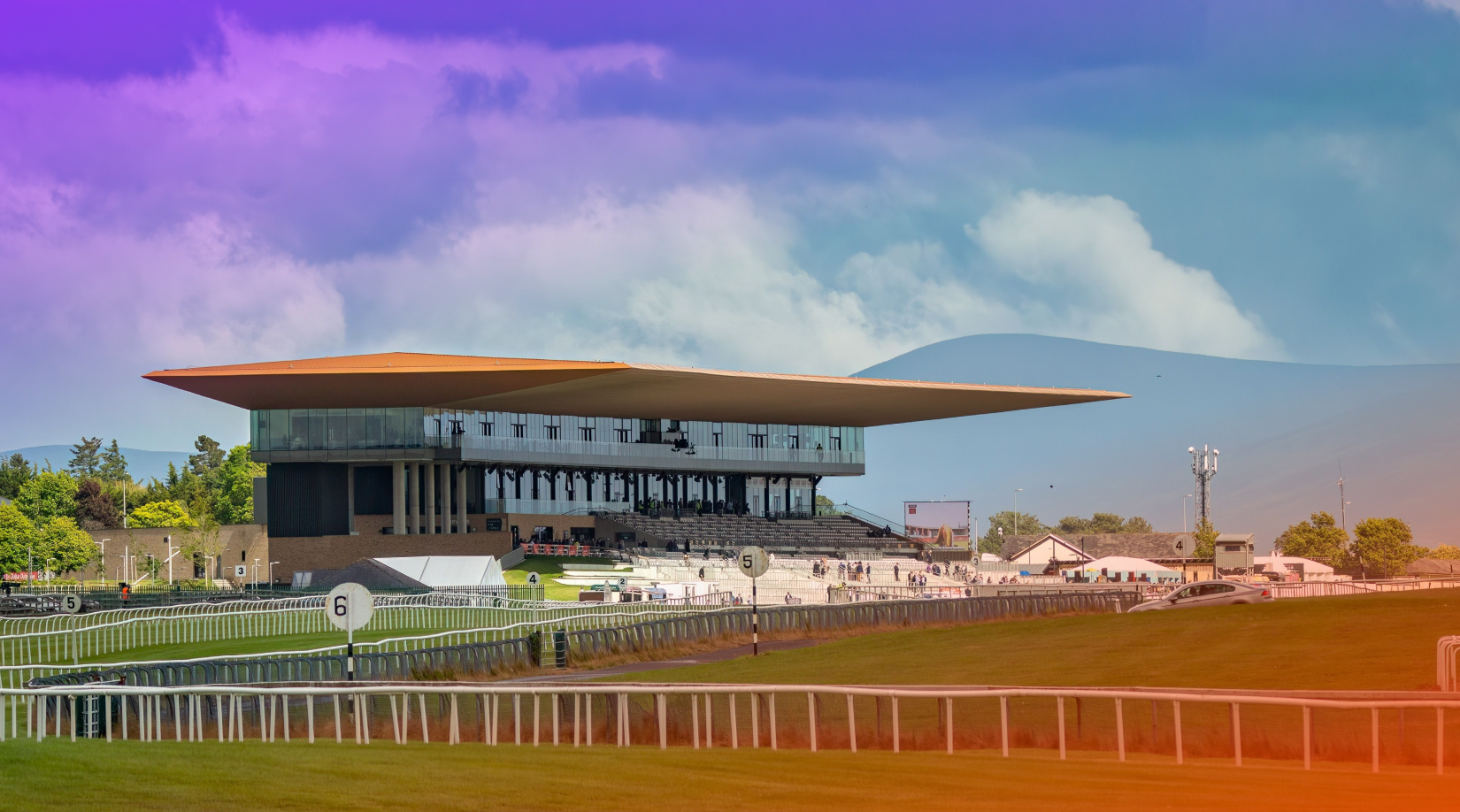| Location: | The Curragh, County Kildare |
| Length: | Two miles in total, featuring 1m 4f and 1m 6f starts |
| Type of Course: | Turf |
| Date Opened: | First recorded race at the Curragh was in 1727 |
| Capacity: | 30,000 max |
| Main Events: | Irish 1,000 and 2,000 Guineas, Tattersalls Gold Cup, Irish Derby, Pretty Polly Stakes, Irish Oaks, Phoenix Stakes, Moyglare Stud Stakes, Vincent O’Brien Stakes and Irish St. Leger |
The epicentre of Irish horse racing and the sport’s beating heart are found at the Curragh. Situated inside the 5,000-acre expanse of the Curragh Plains, the Curragh Racecourse is the centre-point of the Greenlands – an area that serves as a breeding ground for racing industry talent in Ireland.
With over 150 trainers and breeders nestled around the grasslands, the Curragh is home to the greatest concentration of horse racing expertise on the planet. In fact, the word ‘Curragh’ means ‘place of the running horse’, and few places on Earth have had more hooves on soil.
As the track’s slogan asserts, the Curragh Racecourse is “Where Champions Are Made”, and as Ireland’s premier racing venue, it stages all of the country’s biggest events, including the Guineas Festival, the 1,000 & 2,000 Guineas, the Irish Derby, the Oaks, the St. Ledger and more.
A history of Curragh Racecourse
The Curragh’s association with racing spans centuries, and there is even strong evidence to suggest that the area hosted chariot races as early as the third century.
Other whispers rooted in folklore name the Curragh as the setting for mythological figure Fionn mac Cumhaill’s races against his warrior kin, as well as the location of the miraculous tale of St. Brigid and her cloak.
More accurate historical records also offer insight into the 200-year link between the racecourse and the more recognisable version of horse racing, with the first recorded meeting at the Curragh taking place in 1727.
Back then, it was the Irish Turf Club that was established with the remit of organising racing at the course, and that body was eventually made the principal association for equestrian sport in Ireland as a whole.
In 1868, the sport’s organisation took a leap in a new direction with the passing of the Curragh of Kildare Act. That move secured the right of common pasture across the Curragh Plains area, which conserved the use of the region for equestrian pursuits.
The oldest of Ireland’s most famous events, the Irish Derby, was first hosted at the Curragh Racecourse in 1866, while the equally renowned Irish Oaks was introduced there in 1895. In 1915, the Irish St. Leger was inaugurated and added to the list of prestigious races run at the Curragh.
The Anglo-Irish Treaty of 1921 saw the land change hands from British control to the Irish Minister for Finance, before it was eventually passed on to the current administrator, the Minister for Defence. Indeed, approximately 2,000 Irish troops are stationed in the region today.
In the same year, 1921, the 2,000 Guineas was born, 12 months before the 1,000 Guineas joined it, while the Tattersalls Gold Cup and Pretty Polly Stakes were launched in 1962 and 1978 respectively.
While improvements had been consistently rolled out at the Curragh over the past century, the racecourse underwent a massive redevelopment a little over five years ago, with new works costing approximately €80m carried out at the venue.
Designed by Grimshaw architects, the ribbon was cut on the updated facilities in 2019, a little under four years after the first ground on the project was broken.
As part of the best-in-class redevelopment, renovations were made to all buildings, track sightlines and public facilities, with the new-look Aga Khan grandstand being the project’s centre-piece.
The Curragh circuit
Unsurprisingly, the track at the Curragh has been tweaked and reworked numerous times since the early 1700s, though the circuit as it stands today is a truly unique setting.
The Curragh Racecourse is a right-handed, two-mile run with gentle bends and undulations. Aptly, it’s horseshoe-shaped and is considered one of the fairest settings in the sport across the UK and Ireland. The uphill final surge at the track can demand stamina from horses competing there, and that has a knack for producing exciting finishes.
On the straight course, there are starting points at five furlongs, six furlongs, six furlongs 63 yards, seven furlongs and a mile, while the Derby (inner horseshoe) and Plate (outer) are used for different disciplines and distances, depending on what’s required.
The make-up of the track means that there is no complete circuit at the Curragh, however, and the maximum length of races is restricted for that reason.
What makes the Curragh special?
In many ways, a trip to the Curragh Racecourse is a pilgrimage to the spiritual home of Irish racing, and a jaunt into Kildare’s Greenlands for a meeting guarantees an immersive, magical experience for both hardened racing fans and newcomers alike.
Even on non-race days in the region, you’re likely to encounter champions-in-training as the country’s best thoroughbreds are put through their paces across the plains.
At the Curragh Racecourse during meetings, you can expect a vibrant atmosphere as the best trainers and jockeys descend on Kildare alongside hordes of excited spectators and punters.
Once inside, the view is breathtaking as horses race against the awe-inspiring backdrop of rolling grasslands in an area steeped in horse racing traditions. The facilities have been modelled to match and attendees have the best of everything at their fingertips at the racecourse.
There is excellent food on offer in the St. Leger and Oaks restaurants at the Curragh, while an array of cafés and bars are waiting to be explored across the three-storey Grandstand.
The Curragh Racecourse showcases flat racing of the highest calibre in a world-class environment. The wallop of hooves on turf and the cheers of excited onlookers can combine to spark a sensory overload once the action starts, so prepare to be exhilarated!
Key events at Curragh
Racing at the Curragh takes place annually from March right through to October, with 19 separate meetings lined up over the eight-month season. The biggest draw is always the Irish Derby in late June, though several other key events at the racecourse are hugely popular.
The Irish 1,000 and 2,000 Guineas as well as the Tattersalls Gold Cup take place every year in an action-packed May programme, which kicks off each new season in style.
In June, punters have sunshine and entertainment to absorb at the three-day Irish Derby Festival, while the Irish Oaks is a two-day event held in July. Alongside the Classics, there are other supplementary meetings to explore in Kildare.
Ahead of the 2024 flat season, administrators at the Curragh announced a change to the prizes on offer for winners at the track, with an enhanced minimum prize fund of €20,000 for each of the races held there this year.
View a full list of events at the Curragh Racecourse for 2024 below:
May
• Guineas Festival Trials (6th)
• Tattersalls Irish Guineas Festival Day 1 (24th)
• Tattersalls Irish Guineas Festival Day 2 (25th)
• Tattersalls Irish Guineas Festival Day 2 (26th)
June
• Junefest Race Evening (5th)
• Dubai Duty Free Irish Derby Festival Day 1 (28th)
• Dubai Duty Free Irish Derby Festival Day 2 (29th)
• Dubai Duty Free Irish Derby Festival Day 2 (30th)
July
• Juddmonte Irish Oaks Weekend Day 1 (20th)
• Juddmonte Irish Oaks Weekend Day 2 (21st)
August
• Summer Saturday Series (10th)
• Summer Saturday Series (17th)
• Summer Saturday Series (24th)
• Summer Saturday Series (31st)
September
• Irish Champions Festival (15th)
• Goffs Million Day (28th)
• Friends Of The Curragh Irish Cesarewitch (29th)
October
• Brigid’s Pastures Stakes Day (5th)
• Student Derby (17th)
• Staffordstown Stud Stakes (22nd)
November
• Finale of Irish Flat Season (3rd)
Racing coverage
At TonyBet, you can find extensive markets for all of the season’s horse racing events at the Curragh Racecourse with keenly priced odds and extra place offers provided for customers. With superb prices to avail and every horse racing event covered in depth, we recommend betting on horse racing with TonyBet today!
Explore horse racing bets with TonyBet.




 Simon Winter
Simon Winter 